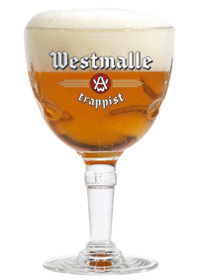The first 100-point beer score ever given by Draft magazine was recently awarded to the Westmalle Tripel.
Westmalle Tripel is a clear, golden yellow Trappist beer that undergoes a secondary fermentation in the bottle (9,5% alcohol). It is a complex beer with a fruity aroma and a nice nuanced hop scent. It is soft and creamy in the mouth, with a bitter touch carried by the fruity aroma. An exceptional beer, with a great deal of finesse and elegance. And with a splendid long aftertaste.
The Westmalle Tripel is indeed called the “mother of all tripels”. This type of beer was first brewed in Westmalle abbey in 1934 when the new brewing hall came into use. The current formula has stayed practically unchanged since 1956, thus more than 50 years.
Westmalle is exclusively imported in the United States from Belgium by Merchant Du Vin. The Beer Wench has located the Westmalle Tripel at both Bodega in the Short North and Grapes of Mirth in the North Market.
The Abbey of Westmalle is one of only seven Trappist breweries in the world. The monastery is located in the village of West Malle, Province of Antwerp, Belgium, and was founded in 1794. Both the Dubbel and the Tripel are considered by many tasters as the benchmarks for the style. Westmalle Dubbel was first brewed for consumption within the Abbey around 1836; Westmalle Tripel was introduced in 1934. (Source: Merchant Du Vin)
THE DEFINITION OF A TRAPIST BEER
A Trappist beer is somewhat different to an abbey beer. Out of all the beers in the world, only seven of them can use the name ‘Trappist’: Achel, Chimay, La Trappe, Orval, Rochefort, Westvleteren and Westmalle. You can recognise them from the “Authentic Trappist Product” logo.
A Trappist beer is only given this name if it satisfies a number of strict criteria:
- The beer is brewed within the walls of a Trappist abbey, by the monks themselves or under their supervision.
- The brewery must be controlled by the monastery and have a business culture compatible with the monastic project.
- The purpose of the brewery is not to make a profit. The income takes care of the livelihood of the monks and the upkeep of the abbey site. What is left over is used for charitable purposes, social work and people in need.
The Trappist breweries produce beers of an impeccable quality that is permanently controlled. Thus a Westmalle Trappist contains 100% natural ingredients.
Trappist breweries strictly observe all standards in the areas of safety, health and consumer information. And the style of communication and advertising is one of honesty, austerity and the modesty appropriate to the religious environment in which the beers are brewed. (Source: Westmalle Abbey)




My mouth is watering for a taste of this one.
Where in Orange County, NY (or vicinity) can I find it?
Thanks for the clarification of Trappist breweries, who knew reading about beer would actually be interesting and educational?!
I cannot wait to try this one… Thanks for the great post.